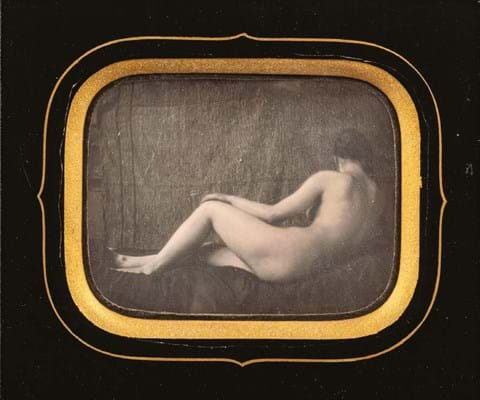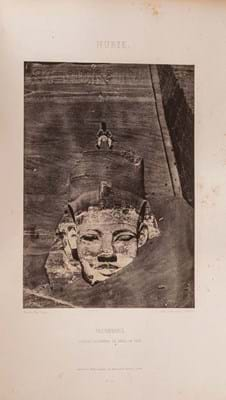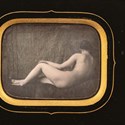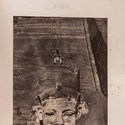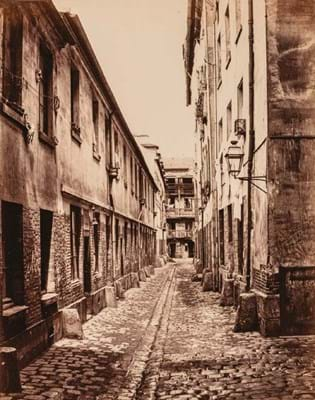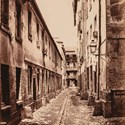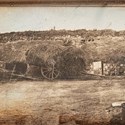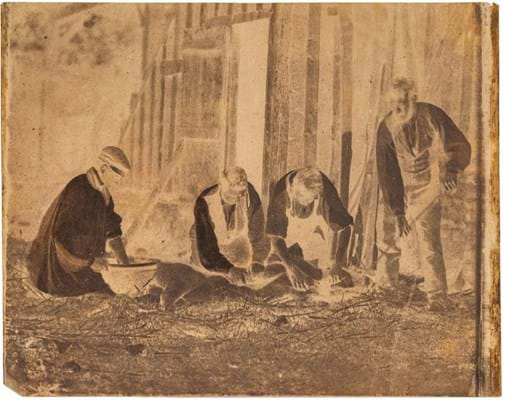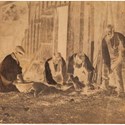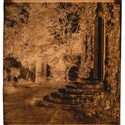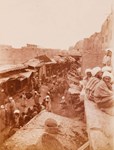
Alphonse Eugène Hubert’s still life dagueurreotype from c.1840 which led Millon’s sale of the François Lepage collection of photographs at €420,000 (£365,215).
Early November was a good time to offer the market a photograph collection in Paris.
With all the exhibitors and visitors in town for the November 10-13 staging of Paris Photo, the French capital’s annual specialist fair, there was no shortage of potential buyers which is why many Paris auction houses time their photo sales to coincide with the event.
And Millon (33/30/25/20% buyer’s premium inc VAT) had a particularly choice consignment to send to market: the collection of François Lepage who died earlier this year.
Lepage was one of the first dealers to take an interest in collecting photographs back in the 1960s, starting with André Jammes then Lepage and Gérard Lévy, who traded in the St Ouen market and had a working partnership for over a quarter of a century before they went their separate ways and divided their stock.
Early works
Lepage was particularly interested in the work of some of the earliest French photographers, the photos primitifs by pioneers in the field and their followers spanning the 1840s-50s, names such as Hippolyte Fizeau, Alphonse Eugène Hubert, Louis Auguste Bisson, Louis Adolphe Humbert de Molard, Eugène Durieu, Gustave le Gray and John Beasley Greene.
Works by all these photographers and many more, including some yet to be identified, featured in the auction of around 230 lots held by Millon on November 10, with Fizeau, Humbert de Molard and Beasley Greene represented by substantial offerings. It was a rich feast for those interested in works from the dawning years of photography and just beyond.
Jammes and Levy’s collections have already been dispersed at auction; the former in memorable auctions at Sotheby’s between 1999 and 2008 and the latter by Millon/Baron Ribeyre in 2016/17 and 2021, so this represented another opportunity to acquire works from a pioneering collector/dealer.
The decision to hold the sale at the time of Paris Photo was particularly key, explained the sale’s expert Christophe Goeury, because with so much early 19th century work on offer it was important for potential buyers – collectors, dealers and major museums or their representatives, many of whom are based in the US – to be able to view the works in person. To this end Millon had put on a week of viewing before the auction.
After the sale Goeury felt the auction was seen as sufficiently important to bring together all the major players in this field with dealers, collectors and institutions all keen to participate and all the major US museums represented.
And testimony to institutional interest from France (a large proportion of the works on offer were examples of French photography) was that there were 15 preemptions by French institutions: The Musée d’Orsay; Bibliothèque Nationale de France; Centre des Monuments Nationaux; Archives Départementales des Pyrénées Atlantique; Patrimoine de la médiathèque de la photographie and La Bibliothèque municipale du Havre.
Many of the lots exceeded estimates, sometimes by considerable margins and it all added up to a premium-inclusive total of around €2.5m.
Successful experiment
A significant slice of that was provided by a single lot. Topping the bill by a huge margin at no less than €420,000 (£365,215) was a rare example of a photograph by Alphonse Eugène Hubert (pictured top), a young architect who was Daguerre’s technical collaborator helping to prepare the plates for his photographic trials.
The full-plate daguerreotype in the Lepage collection, measuring 6 x 8in (15 x20cm) visible and 12¼ x 14in (31 x 36cm) including the frame, dated from 1839-40. It depicted a ‘still life’ of the typical types of objects one might see in a cabinet of curiosities or artist’s studio but the arrangement was as much for technical as aesthetic reasons – to assess the effect of sunlight on the different metal, fabric and stone surfaces.
The technically experimental nature of the image was underscored by a bonus of a manuscript inscription to the reverse by Fizeau translating as Daguerreotype with gold chloride fixing Mr Hubert architect 1840. It was Fizeau, a physicist known for his work with Jean Bernard Leon Foucault on determining the speed of light and also a photographic pioneer, who conducted experiments that used chemically coated plates to speed up and fix development.
The lot also came with a page of Lepage’s research notes on the daguerreotype.
So the photograph had significance as a scarce experimental work from the dawn of photography, and prompted huge interest that took the bidding way past Ader’s estimate of €60,000-80,000 in a battle between a US museum and a French collector with the former emerging as the victor.
Nadar price no joke
The sale contained a group of photographs by Nadar (Félix Tournachon 1820-1910), offered as ten lots, some of them produced in collaboration with his brother Adrien Tournachon (1825- 1903) with whom he worked for a period at the beginning of his photographic career.

Pierrot with a basket of fruits, a paper print from c.1854-55 by Nadar (Félix Tournachon) and his brother Adrien Tournachon – €120,000 (£104,350) at Millon.
Pierrot with a basket of fruits is one of these collaborative works: a tanned gelatin paper print measuring 11 x 8in (28 x 20cm), c.1854-55, from the series of 15 Têtes d’expression de Pierrot featuring the mine artist Deburau.
It had a stamp in the image and stamp signature on the mount. Unlike the Hubert, this is a well-known and published image that featured in the Nadar, les années créatrices: 1854-1860 exhibition at the Musée d’Orsay and the Metropolitan Museum of Art in New York from 1994-95.
It carried the highest estimate in the auction at €120,000-150,000 and found a buyer at the low estimate, €120,000 (£104,350).
Fizeau fever
With no fewer than 19 lots the consignment of works by Fizeau (1819-96) was significant. Virtually all the Fizeau elements in this auction comprised daguerreotypes of varying sizes from around 1840.
Although his work does appear at auction occasionally it is some time since a large body of work of this nature has surfaced. What made this additionally significant is that he is known for his city views – mostly of Paris and some of Le Havre – but the Lepage offering featured a number of rural scenes. These were taken in Suresnes where Fizeau’s father had a house and from where the physicist conducted some of his light experiments.
Many sold for prices that were way past estimates that Goeury explained were a bit of guess given that lack of recent precedent.
Topping the list at over three times the €8000-10,000 top estimate was the €32,000 (£27,825) paid for a half plate daguerreotype of the port at Le Havre with an image size of 4 x 6in (10 x 15.5cm).
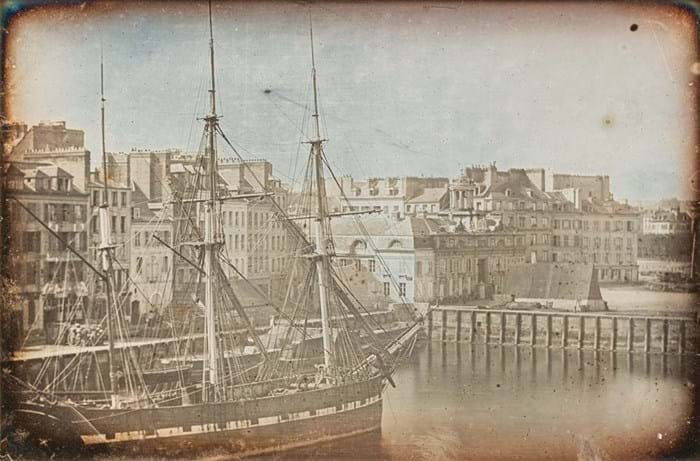
This half-plate daguerreotype of Le Havre was the most expensive of the 19 lots by Hippolyte Fizeau at €32,000 (£27,825) at Millon.
A second half plate view of the port was pre-empted for €16,000 (£13,915) by the Bibliothèque Muncipale du Havre. It is thought that the juxtaposition of the two scenes may have meant that Fizeau was intending to create a panorama.
The Bibliothèque also pre-empted a second Fizeau, a sixth plate 2¼x 3½in (6 x 9cm) daguerreotype showing a distant view of Le Havre seen from the heights of Sainte- Adresse for €7000 (£6085).
Overall there were five Fizeau preemptions, the other three all being half plate rural views around Suresnes, which were secured by the Musée d’Orsay, two for €20,000 (£17,390), the other €10,000 (£8695).
Normandy group
Louis Adolphe Humbert de Molard (1800-74) from the Normandy group of photographers, who took up photography in the early 1840s, was represented by 28 lots.
Most of these sold but prices were not as high as for the Fizeaus, perhaps because the vast majority of these were paper negatives which, felt Goeury, are not as easy to display.
Many of them were rural genre scenes set on the Humbert de Molard’s estate in Normandy; the most expensive being a 7¼ x 9in (18.5 x23cm) paper negative from c.1848 depicting a group of four men in a farmyard butchering a pig which sold for €11,000 (£9565) against a guide of €6000-8000.
£1 = €1.15


